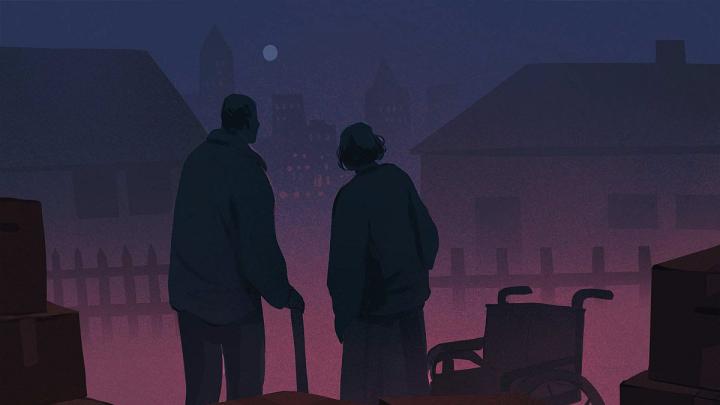As the ranks of American seniors swell with aging baby boomers, most say they hope to age in place. But that may not be possible, experts at Harvard’s Joint Center for Housing Studies (JCHS) predict. They note that there is an acute lack of safe, affordable, and accessible housing options to accommodate this swelling demand. JCHS projects that U.S. households headed by someone more than 80 years old will number 17.5 million in 2038—more than twice the 8.1 million of 2018— accounting for 12 percent of all households.
For many, aging in place is about remaining in the home they have lived in and, in some cases, owned for decades, says lecturer in urban planning and design Jennifer Molinksy, who directs the JCHS’s Housing an Aging Society Program. For others, it means relocating to a smaller apartment or residence within their longtime community or neighborhood. Yet each approach requires different supports, structures, and policy prescriptions.
“When we talk about aging in place, we need to remember the home but also the larger place—does it have the amenities and transportation alternatives and walkability and opportunities to engage in the community that you might want or need?” asks Molinksy, a coauthor of several reports on older adults’ housing requirements. “We’re also thinking a lot about how tied services and supports are to staying in the home. So, it’s not only about the home and neighborhood, it’s also about ensuring access to the services and supports people need to stay safely there.”
Lessons from the pandemic may help guide the way. A 2022 report by Molinsky and colleagues from Harvard and the Hastings Center, a bioethics research institute, outlines the various challenges facing older adults and highlights a range of improvised responses that helped those stuck at home during COVID lockdowns.
One challenge involved a loneliness epidemic that is not going away. The Joint Center predicts the number of adults 80 and above who live alone will reach 10.1 million by 2038; loneliness and isolation are linked to a range of serious health risks. Researchers found that support networks can be vital in aiding isolated seniors and helping older adults age in place. During the pandemic, agencies devoted to health, housing, and aging services coordinated closely with grassroots groups, local leaders, members of neighborhood coalitions and others to share strategies, resources, and best practices.
In Massachusetts, government agencies and non-profit partners “shared information and guidance with affordable senior housing communities,” notes the report. It also cites the work of the New York Academy of Medicine’s Center for Healthy Aging, which arranged monthly virtual meetings “with representatives of neighborhood-based age-friendly organizations, elected officials, and service providers in New York City to share strategies for meeting older adults’ needs around food access, social isolation, and access to information and technology.”
“Collaborations were built around a shared knowledge of the issues and challenges seniors face, and they engendered a deep sense of trust,” says Molinksy. The networks, which facilitated everything from convincing state officials to prioritize senior housing and nursing homes in their vaccine rollout plans, to providing internet service, computer tablets, and technology training to thousands of public-housing residents, “can definitely be a model for others.”
Another challenge is affordability. Older adults with limited financial resources face a much lower chance of successfully aging in place. Many middle-income earners who can’t afford elder housing or support services make too much or have too many assets to qualify for government assistance. And even well-resourced seniors face financial hurdles, with 2.4 million older homeowners paying more than 30 percent of their income for housing on top of tax, insurance, and utility payments, Molinksy says. Many older homes will also require expensive updates to make them more accessible, such as retrofitting wider hallways and doors, ramps, and first-floor bathrooms.
“There are also costs involved in maintaining a home, and we’ve seen a dramatic rise in the number of older adults paying mortgages into their 80s,” Molinsky says. A record hot housing market fueled in part by the pandemic left more older people living in high-cost, medium- and low-density areas who are eager to relocate within their community but “unable to sell their house for enough to get that condo,” she continues. When older adults are prevented from downsizing, younger adults seeking spacious, safe housing for their growing families are in turn left with fewer options.
Many older adults who prefer to move rather than renovate are turning to shared living arrangements. Joining multigenerational households was a trend early in the pandemic before the development of vaccines. One change that could help, says Molinsky, is “zoning that allows for accessory dwelling units, which can provide the extra space some households need.” Similarly, house-sharing between two older adults or with a younger student has become increasingly popular, she says. And of late, many low- and middle-income adults are opting for congregate settings, such as independent senior housing that offers services including meals, care coordination, and transportation.
The new report emphasizes the importance of involving older voices in planning a sustainable future for all seniors. It highlights how religious and community leaders across the country enlisted older volunteers to keep their peers informed about the benefits of vaccination. And it points to the efforts of Together We EngAGE, a California initiative to solicit input from older adults about the state’s Master Plan for Aging, which ultimately brought “aging and disability rights policy topics to the forefront of California’s public discourse.”
The pandemic also forced many people to reconsider the physical design, features, and accessibility of houses, apartments, and neighborhoods, including access to fresh air, green space, reliable elevators, and backup generators. The report includes accessible design guidelines and stresses the importance of Habitat for Humanity and the Community Aging in Place—Advancing Better Living for Elders organizations, which can connect older adults with a registered nurse, an occupational therapist, and a handy worker to help them improve accessibility throughout their homes.
Technology can play a key role in helping people age in place, too, Molinksy says, citing the growth in telehealth appointments and virtual doctor visits during pandemic lockdowns. She is studying such concepts as “hospital in the home,” in which patients receive acute care in the comfort of their bedrooms with the support of video monitors and doctors’ visits.
Perhaps her overarching message is the need to fundamentally rethink the aging narrative in the United States and beyond. Older adults are too often seen in terms of their health needs, says Molinsky, who instead supports a housing-first approach: “We look at aging, often, through a medical lens. And we looked at the pandemic through a public health lens. But our argument is that we really need to start where people live. We’ve got to take a housing approach—that’s where people are spending most of their time. And then…we can think about how we can support older adults better.”









